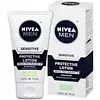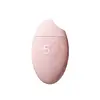What's inside
What's inside
 Key Ingredients
Key Ingredients

 Benefits
Benefits

 Concerns
Concerns

 Ingredients Side-by-side
Ingredients Side-by-side

Butyl Methoxydibenzoylmethane 3%
UV AbsorberEthylhexyl Salicylate 4.7%
UV AbsorberOctocrylene 8.4%
UV AbsorberWater
Skin ConditioningIsopropyl Palmitate
EmollientGlycerin
HumectantTapioca Starch
Cetearyl Alcohol
EmollientGlyceryl Stearate Citrate
EmollientTocopheryl Acetate
AntioxidantPanthenol
Skin ConditioningChamomilla Recutita Flower Extract
MaskingHamamelis Virginiana Bark/Leaf Extract
Astringent1,2-Hexanediol
Skin ConditioningCarbomer
Emulsion StabilisingEthylhexylglycerin
Skin ConditioningMaltodextrin
AbsorbentCaprylic/Capric Triglyceride
MaskingAcrylates/C10-30 Alkyl Acrylate Crosspolymer
Emulsion StabilisingSodium Hydroxide
BufferingTrisodium EDTA
Phenoxyethanol
PreservativePiroctone Olamine
PreservativeParfum
MaskingButyl Methoxydibenzoylmethane 3%, Ethylhexyl Salicylate 4.7%, Octocrylene 8.4%, Water, Isopropyl Palmitate, Glycerin, Tapioca Starch, Cetearyl Alcohol, Glyceryl Stearate Citrate, Tocopheryl Acetate, Panthenol, Chamomilla Recutita Flower Extract, Hamamelis Virginiana Bark/Leaf Extract, 1,2-Hexanediol, Carbomer, Ethylhexylglycerin, Maltodextrin, Caprylic/Capric Triglyceride, Acrylates/C10-30 Alkyl Acrylate Crosspolymer, Sodium Hydroxide, Trisodium EDTA, Phenoxyethanol, Piroctone Olamine, Parfum
Water
Skin ConditioningEthylhexyl Methoxycinnamate
UV AbsorberOctocrylene
UV AbsorberButyl Methoxydibenzoylmethane
UV AbsorberBis-Ethylhexyloxyphenol Methoxyphenyl Triazine
Skin ConditioningTitanium Dioxide
Cosmetic ColorantZinc Oxide
Cosmetic ColorantBifida Ferment Lysate
Skin ConditioningNiacinamide
SmoothingPentylene Glycol
Skin ConditioningGlycerin
HumectantPhenoxyethanol
PreservativeEthylhexylglycerin
Skin ConditioningButylene Glycol
HumectantCentella Asiatica Leaf Extract
Skin ConditioningPolygonum Cuspidatum Root Extract
AntioxidantScutellaria Baicalensis Root Extract
AstringentCamellia Sinensis Leaf Extract
AntimicrobialGlycyrrhiza Glabra Root Extract
BleachingChamomilla Recutita Flower Extract
MaskingRosmarinus Officinalis Leaf Extract
AntimicrobialSodium Polyacrylate
AbsorbentCaprylic/Capric Triglyceride
MaskingParaffinum Liquidum
EmollientTri-PPG-3 Myristyl Ether Citrate
Skin ConditioningSorbitan Laurate
EmulsifyingTrideceth-6
EmulsifyingMagnolia Kobus Bark Extract
Skin ConditioningCaprylic/Capric/Succinic Triglyceride
EmollientWater, Ethylhexyl Methoxycinnamate, Octocrylene, Butyl Methoxydibenzoylmethane, Bis-Ethylhexyloxyphenol Methoxyphenyl Triazine, Titanium Dioxide, Zinc Oxide, Bifida Ferment Lysate, Niacinamide, Pentylene Glycol, Glycerin, Phenoxyethanol, Ethylhexylglycerin, Butylene Glycol, Centella Asiatica Leaf Extract, Polygonum Cuspidatum Root Extract, Scutellaria Baicalensis Root Extract, Camellia Sinensis Leaf Extract, Glycyrrhiza Glabra Root Extract, Chamomilla Recutita Flower Extract, Rosmarinus Officinalis Leaf Extract, Sodium Polyacrylate, Caprylic/Capric Triglyceride, Paraffinum Liquidum, Tri-PPG-3 Myristyl Ether Citrate, Sorbitan Laurate, Trideceth-6, Magnolia Kobus Bark Extract, Caprylic/Capric/Succinic Triglyceride
 Reviews
Reviews

Ingredients Explained
These ingredients are found in both products.
Ingredients higher up in an ingredient list are typically present in a larger amount.
Also known as Avobenzone, this ingredient is a chemical sunscreen filter that provides protection in the UV-A range.
Avobenzone is globally approved and is the most commonly used UV-A filter in the world.
Studies have found that avobenzone becomes ineffective when exposed to UV light (it is not photostable; meaning that it breaks down in sunlight). Because of this, formulations that include avobenzone will usually contain stabilizers such as octocrylene.
However, some modern formulations (looking at you, EU!) are able to stabilize avobenzone by coating the molecules.
Avobenzone does not protect against the UV-B range, so it's important to check that the sunscreen you're using contains other UV filters that do!
The highest concentration of avobenzone permitted is 3% in the US, and 5% in the EU.
Learn more about Butyl MethoxydibenzoylmethaneThis ingredient is an emollient, solvent, and texture enhancer. It is considered a skin-softener by helping the skin prevent moisture loss.
It helps thicken a product's formula and makes it easier to spread by dissolving clumping compounds.
Caprylic Triglyceride is made by combining glycerin with coconut oil, forming a clear liquid.
While there is an assumption Caprylic Triglyceride can clog pores due to it being derived from coconut oil, there is no research supporting this.
Learn more about Caprylic/Capric TriglycerideChamomilla Recutita Flower Extract comes from the Chamomile flower.
Chamomile is rich in antioxidants and has anti-inflammatory properties. Several compounds found in chamomile help with soothing, such as bisbolol.
Antioxidant components in chamomile make it an effective ingredient to help slow the signs of aging. Antioxidants help fight free-radical molecules, or molecules that may damage your skin.
Essential oils from chamomile have been found to improve wound healing due to its antimicrobial properties.
Ancient Greeks and Egyptians used Chamomile to treat skin redness and dryness. Chamomile has also been used to help treat stomach issues.
Learn more about Chamomilla Recutita Flower ExtractEthylhexylglycerin (we can't pronounce this either) is commonly used as a preservative and skin softener. It is derived from glyceryl.
You might see Ethylhexylglycerin often paired with other preservatives such as phenoxyethanol. Ethylhexylglycerin has been found to increase the effectiveness of these other preservatives.
Glycerin is already naturally found in your skin. It helps moisturize and protect your skin.
A study from 2016 found glycerin to be more effective as a humectant than AHAs and hyaluronic acid.
As a humectant, it helps the skin stay hydrated by pulling moisture to your skin. The low molecular weight of glycerin allows it to pull moisture into the deeper layers of your skin.
Hydrated skin improves your skin barrier; Your skin barrier helps protect against irritants and bacteria.
Glycerin has also been found to have antimicrobial and antiviral properties. Due to these properties, glycerin is often used in wound and burn treatments.
In cosmetics, glycerin is usually derived from plants such as soybean or palm. However, it can also be sourced from animals, such as tallow or animal fat.
This ingredient is organic, colorless, odorless, and non-toxic.
Glycerin is the name for this ingredient in American English. British English uses Glycerol/Glycerine.
Learn more about GlycerinOctocrylene protects skin from sun damage. It absorbs UV-B with peak absorption of 304 nm. It is a common sunscreen ingredient and often paired with avobenzone, a UVA filter. This is because octocrylene stabilizes other sunscreen ingredients by protecting them from degradation when exposed to sunlight. Octocrylene is a photostable ingredient and loses about 10% of SPF in 95 minutes.
Octocrylene also acts as an emollient, meaning it helps skin retain moisture and softens skin. It is oil-soluble and hydrophobic, enhancing water-resistant properties in a product.
Those who are using ketoprofen, a topical anti-inflammatory drug, may experience an allergic reaction when using octocrylene. It is best to speak with a healthcare professional about using sunscreens with octocrylene.
The EU allows a maximum of these concentrations:
Learn more about OctocrylenePhenoxyethanol is a preservative that has germicide, antimicrobial, and aromatic properties. Studies show that phenoxyethanol can prevent microbial growth. By itself, it has a scent that is similar to that of a rose.
It's often used in formulations along with Caprylyl Glycol to preserve the shelf life of products.
Water. It's the most common cosmetic ingredient of all. You'll usually see it at the top of ingredient lists, meaning that it makes up the largest part of the product.
So why is it so popular? Water most often acts as a solvent - this means that it helps dissolve other ingredients into the formulation.
You'll also recognize water as that liquid we all need to stay alive. If you see this, drink a glass of water. Stay hydrated!
Learn more about Water